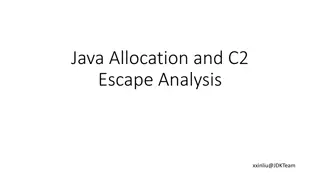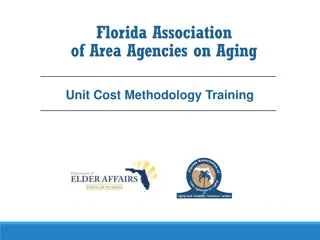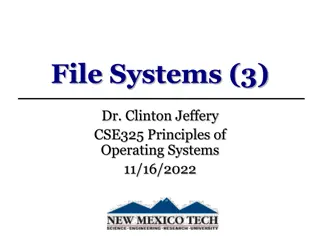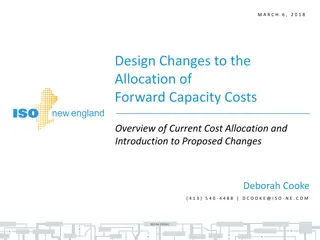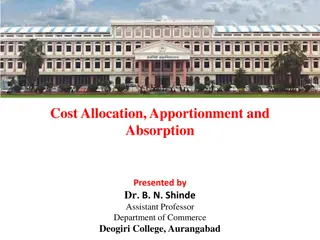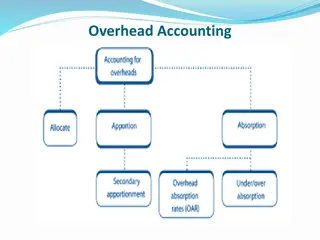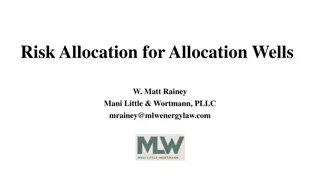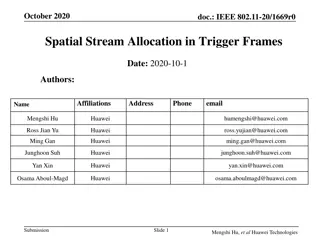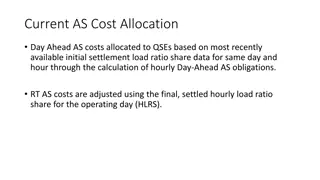Cost of Service Studies Allocation Methodologies
Types of Cost of Service Studies - Embedded and Marginal, Cost Causation, Nevada's Marginal Cost Pricing, NAC Regulations on Marginal Cost Consideration in Revenue Requirements, Rate Design Based on Marginal Cost.
Download Presentation

Please find below an Image/Link to download the presentation.
The content on the website is provided AS IS for your information and personal use only. It may not be sold, licensed, or shared on other websites without obtaining consent from the author.If you encounter any issues during the download, it is possible that the publisher has removed the file from their server.
You are allowed to download the files provided on this website for personal or commercial use, subject to the condition that they are used lawfully. All files are the property of their respective owners.
The content on the website is provided AS IS for your information and personal use only. It may not be sold, licensed, or shared on other websites without obtaining consent from the author.
E N D
Presentation Transcript
Cost of Service Studies April 14, 2016 1
Used to reasonably allocate costs (revenue requirement) incurred by utility amongst customer classes 2 Types of COSS Embedded Look at costs from a historical perspective (some costs that were incurred 15+ years ago) Marginal Look at costs from a theoretical perspective of producing an additional unit of energy and what does it cost to produce that unit. (Argued to be a better price signal for current behavior) 2
The customers that cause the costs pay for those costs=Cost Causation Nevada uses Marginal Cost Pricing to determine the fair share of electric service that each class of customer pays Limit interclass and intraclass subsidies Marginal costing estimates the cost to provide: the next unit of Generation, Transmission, and Distribution demand the next kWh of Energy (including fuel & purchase power cost), the facilities to hook up the next customer (Facilities, Services, Meters), and the cost to provide Billing and Customer Service to that customer NV Energy designs rates to collect the PUCN approved overall and class revenue requirements enhance revenue stability 3
NAC 704.660 Consideration of marginal cost of service in determining class revenue requirements. (NRS 703.025, 704.210) The Commission will consider a utility s marginal (incremental) cost of service to each class of customer in determining the revenue required from that class. [Pub. Service Comm n, Gen. Order 33 2.0, eff. 9-17-82] NAC 704.662 Rate design based on marginal cost of service. (NRS 703.025, 704.210) 1. The rates charged by the utility for supplying electricity to customers of a particular class must reflect the marginal (incremental) cost of serving that class, including any seasonal or hourly differences in the cost of the service, unless the Commission determines, in a proceeding to establish or change the rate, that: (a) In the case of a proposed rate which reflects seasonal differences in the cost of service: (1) Those differences are so insignificant ; or (2) Application of the proposed rate would unreasonably affect the utility s financial condition. (b) In the case of a proposed rate which would reflect hourly differences in the cost of service, the cost of providing meters would be greater than the benefits of conservation of electric energy and efficient use of facilities and resources which would be obtained from use of the proposed rate. (c) In any case: (1) The rate would not be equitable; or (2) The expected level of understanding or acceptance of the rate by the customers of the class to which the rate would apply is such that the rate would not likely serve the purpose of this regulation... 4
How is the marginal cost of service determined and presented? Building Block approach that is summarized by function, class of customer, and Time-Of-Use (TOU) period Cost of the next unit: next customer extension; next bill; next kW of generation, transmission and distribution capacity; next kWh of energy Primary Inputs include: Planning (forecast) and Accounting (historical) data Customer Weighting Factor Study Hourly Cost Responsibility Factors (Allocators) Class hourly load requirements (Load research) Forecast PROMOD modeling data Assumption of a future rate effective year Calculations create hourly costs by function and class for the future rate effective year adjusted by class for losses 5
Costs by Function Generation Transmission Distribution (Facilities) Customer Classified into Variable, Fixed, and Customer Costs are developed by Class and by Hour Costs are then compiled by Time-of-Use ( TOU ) period Marginal costs are reconciled to an embedded revenue requirement and allocated to customer classes using Consumption (total usage), Peak, and Customer count data. 6
Generation Generation Transmission Transmission Distribution Distribution Coal, gas, water, geothermal, nuclear, oil, diesel, solar, or wind. High voltage transportation to load centers. Lower voltage delivery to business & residential customers. Marginal Generation Unit Demand Cost is based on the least capital cost capacity addition (CT) Typically In the past: Marginal Transmission Unit Cost: Demand Costs: Regression Methodology of 17 yr hist & 3 forecast plant & loads Annual Unit Demand Cost assigned to hours based on LOLP Energy Internally generated and purchased energy. Regression Methodology of 17 yr hist & 3 forecast plant & loads Annual Unit Demand Cost assigned to hours based on POP Energy Annual Unit Demand Cost assigned to hours based on POP Facilities Costs: Marginal Facilities Cost, by class, from recent work order data base and some customer-specific investments are not differentiated by TOU. Marginal Energy Costs generated for 8760 hours in PROMOD economic dispatch. They are load weighted and loss-adjusted by class and TOU period. Customer Costs: Meter Costs, Customer Accounting and Customer Services Costs are not differentiated by TOU 7
Meter investment, Meter O&M Customer account expenses (901-904) Customer accounting and collection activities including: Supervision Meter reading Customer records Uncollectible accounts Customer information expenses (907-909) Customer service and information activities encouraging safe use and conservation including: Supervision Customer assistance Informational and instructional advertising Adders and carrying charges 12
Method of allocating customer accounts and service expenses to customer classes: Customer Accounts Expense (FERC 901-905); Customer Services Expense (FERC 907-910). Departmental Surveys are completed to individually identify customer classes being served by each area. Weights are developed on an expense per customer basis relative to residential classes (Residential weight = 1.00). 13
Cost causation -determined by Probability of Peak (POP) cost responsibility factor Those hours in year that are 90% or greater of annual peak are determined to contribute to requirement for additional T&D capacity. Classes with load requirements that correspond to the peak hours will be assigned greater T&D costs. Based on a regression of 17 yr historical & 3 yr forecast plant and loads. Same methodology as previously approved with 2 more historical years of data. 14
Same Methodology as previously approved 10 years of historical hourly system sales 1 year of forecast hourly system sales (PROMOD) Generally only one year is used as all forecast years utilize the same base load shape. Probability of Peak is calculated for every hour in every year to normalize for load growth. Probabilities calculated assuming normal distribution. 15
Same methodology as previously approved Installed cost of generation is based on the estimated cost of a combustion turbine. Cost causation determined by Loss of Load Probability (LOLP) cost responsibility factor. Multiple years of forecast PROMOD data Those hours of the year with loads likely to exceed available capacity result in a probability that load will be lost and contribute to the requirement for additional Generation capacity. Classes with load requirements that correspond to the hours with higher probability of lost load will be assigned greater Generation demand costs. 16
Typically 3-5 years of PROMOD data is used Period selected will precede the year of new generation addition(s) Calculation Hourly values averaged over the period and mapped to test year by Month, Day of Week and Hour Sum-normalized in test year (100%) Creates percent of total LOLP value for each hour 17
Cost causation determined by hourly rate effective period (usually three forecast years) MEC PROMOD data provided by Resource Planning Department Adjusted for losses by class dependent on voltage level Classes with hourly sales that correspond to hours with higher MEC costs will be assigned relatively higher marginal energy revenues in the MCS, on a $/kWh basis 18
Marginal costs are reconciled to the target revenue requirement, which is the revenue requirement adjusted for class revenues not developed in the reconciliation. This ensures the Company only collects the actual revenue requirement in proposed rates. Reconciliation is done by function on an Equal Percent of Marginal Cost ( EPMC ) basis. The EPMC method is objective and fair in its application if a customer class is responsible for 10% of the marginal cost it is reasonable to assign to it 10% of the revenue requirement. Distribution and Transmission are reconciled separately. Generation & Energy are reconciled together because of their interrelated nature. 20
Distribution Marginal Cost Revenues Transmission Marginal Cost Revenues Generation & Energy Marginal Cost Revenues Generation Demand & Energy before Hoover B and WAPA adjustment ---N--- 198,986 $ 774,249 3,430 51,658 299,749 184,545 5,803 - 85,266 185,190 32,297 809 29,595 43,939 1,062 838 - 355 898 - 7,549 40 130 Adjustment for Other Revenue Assigned to Specific Classes ---E--- $ Cost Based Class Revenue, before CSF & After Other Revenue ---F--- $ 197,684 WAPA, Hoover B Credit, & Res. Plan Recovery ---Q--- $ $ $ Adjustment for X Class Cust Spec. Facilities ---G--- $ Distribution Cost Based Class Revenue ---H--- $ 197,684 Transmission Cost Based Class Revenue ---K--- $ Energy before Hoover B and WAPA adjustment ---M--- $ Energy Cost Based Class Revenue, before Adjustments ---P--- 166,717 $ 648,695 251,141 154,619 155,159 Energy Cost Based Class Revenue ---R--- 166,110 $ 646,544 43,281 251,141 154,619 71,439 155,159 26,261 24,796 36,813 Line No. Total Distribution Services ---C--- $ 275,581 Transmission Demand ---I--- $ Percent of Total ---J--- 10.86% 47.48% 0.20% 2.26% 14.36% 8.31% 0.23% 0.00% 3.71% 7.85% 1.44% 0.04% 1.27% 1.85% 0.02% 0.03% 0.00% 0.01% 0.03% 0.00% 0.05% 0.00% 0.00% Generation Demand ---L--- 106,359 $ Percent of Total ---O--- 10.44% 40.61% 0.18% 2.71% 15.72% 9.68% 0.30% 0.00% 4.47% 9.71% 1.69% 0.04% 1.55% 2.30% 0.06% 0.04% 0.00% 0.02% 0.05% 0.00% 0.40% 0.00% 0.01% Class ---B--- Percent of Total ---D--- 12.89% 51.56% 8 9 10 11 12 13 14 15 16 17 18 19 20 21 22 23 24 25 26 27 28 29 30 31 32 33 34 35 36 37 RM RS LRS GS LGS-1 LGS-2S LGS-2P LGS-2T LGS-3S LGS-3P LGS-3T LGS-XS LGS-XP LGS-XT LGS-2S-WP LGS-2P-WP LGS-2T-WP LGS-3S-WP LGS-3P-WP LGS-3T-WP SL RS-Pal GS-Pal 68,877 (1,930) (2,256) 48,042 - 48,042 16,973 74,210 305 3,532 22,447 12,989 366 18,969 82,937 341 3,947 25,087 14,516 409 92,626 331,860 1,641 31,110 169,742 108,315 3,626 (607) (2,150) (11) - - - - - - - - - - 442,390 1,789 20,548 130,007 76,230 2,178 938 0.18% 7.10% 12.56% 6.45% 0.16% 0.00% 2.51% 5.03% 0.37% 0.01% 0.42% 0.04% 0.06% 0.03% 0.00% 0.01% 0.03% 0.00% 0.54% 0.02% 0.05% (1) 679 679 2,874 43,281 2,863 37,946 67,120 34,471 866 (406) (107) (2) 27,125 48,590 25,007 628 27,125 48,590 25,007 628 - - 4,862 4,862 - - - - - - - - - 13,395 26,899 1,965 (0) (0) - - - - - - - - - - (4) (0) (0) 9,718 19,516 1,426 9,718 19,516 1,426 5,802 12,275 2,254 6,484 13,718 2,520 34,706 74,187 12,689 374 12,100 17,611 205 247 50,559 111,003 19,608 71,439 27,060 677 24,796 36,813 890 702 $ (799) 62 45 23 68 61 68 435 677 2,267 201 318 148 1,645 146 231 107 867 649 2,512 795 231 107 1,993 2,898 2,227 3,239 17,495 26,328 857 591 $ - - - - - - - - - - 29 42 33 47 890 702 - - - - - - - - - 65 47 47 8 9 31 324 680 297 752 297 752 160 116 116 42 47 218 - - - - - - - - - 2,894 2,095 2,095 84 94 772 6,777 6,325 6,325 86 62 62 0 0 0 0 2 7 38 34 $ (0) 34 251 182 182 123 109 109 TOTAL Functionalized Rev Requirements: Adjustments: $ 534,509 100% $ $ $ $ (4,707) 384,631 383,092 387,799 $ 383,092 $ 1,539 $ 384,631 $ 156,311 100.00% $ $ 174,692 174,692 111.76% $ 932,651 $ $ $ $ 973,738 624,890 968,785 1,593,675 1,906,389 $ Gen RR Eng RR Total G&E RR 1,597,243 $ (3,568) 1,593,675 $ Less Cust. Spec Revenues Plus Other Revs Transmission Reconciliation Factor $ 1,597,243 $ 83.60% G&E Reconciliation Factor 3,568 Plus WAPA & Hoover B Cr. Total Adjusted RR Other Revenue from: misc. revenues, returned check, power pedestal, and misc. damage 72.6% Dist Reconciliation Factor Sum of Additional Facilities & Maintenance (AF&M) Contract Revs ----F2---- $ Functional Cost Based Class Revenue Before PF and AF&M ----C2---- 233,122 $ 927,166 324,818 194,142 188,392 Sum of Functional Cost Based Class Revenue (To Page 7) ----G2---- 233,122 $ 927,166 324,877 194,373 188,842 Capped Class Revenue Requirement (From Page 7) ----H2---- 241,295 $ 887,856 336,266 201,188 195,463 Overall Effective Rate (not including Rule 9 Facilities Revenue) ----M2---- $ Overall Effective Rate (all revenues) ----L2---- 0.12328 $ 0.12871 0.11604 0.11097 0.09188 0.08571 0.07602 Power Factor Adjustment ----E2---- $ Percent of Total ----J2---- 11.20% 41.22% 0.19% 3.49% 15.61% 9.34% 0.28% 0.00% 4.22% 9.07% 1.40% 0.03% 1.43% 1.94% 0.05% 0.04% 0.00% 0.02% 0.04% 0.00% 38 39 40 41 42 43 44 45 46 47 48 49 50 51 52 53 54 55 56 57 58 59 60 61 62 63 64 65 Class ----B2---- Percent of Total ----D2---- 10.83% 43.06% Revenue Proof ----I2---- 241,300 $ 887,859 336,264 201,188 195,462 Rounding ----K2---- $ ----Q2---- ----R2---- Verification of Revenue Requirement RM RS LRS GS LGS-1 LGS-2S LGS-2P LGS-2T LGS-3S LGS-3P LGS-3T LGS-XS LGS-XP LGS-XT LGS-2S-WP LGS-2P-WP LGS-2T-WP LGS-3S-WP LGS-3P-WP LGS-3T-WP - - 5 3 0.11840 0.11981 0.11007 0.08664 0.08872 0.08377 0.07555 - - - - - - 2,171,305 $ (18,307) $ 2,152,998 $ Total Sales Revenue (pg 1) Revenue Credits (pg 1) 3,884 74,353 0.18% 3.45% 15.09% 9.02% 0.27% 0.00% 4.07% 8.75% 1.40% 0.04% 1.37% 1.90% 0.05% 0.04% 0.00% 0.02% 0.04% 0.00% 3,884 74,353 4,020 75,100 4,020 75,098 (0) (1) (3) 0 0 - 0 (1) (0) (0) 0 (0) 0 (0) - (0) 0 - 58 1 - - - - 231 18 2,154,164 $ $ $ 2,171,309 $ $ 2,171,305 $ Revenue from Proposed Rates Addin Rev. Req. Adjustment Add in Rev. Credit Adjustments. 5,899 5,917 6,124 6,124 - - - - - - 17,146 87,641 118 230 46 87,759 90,835 90,836 0.08251 0.07938 0.06876 0.07983 0.07946 0.07107 0.05383 0.06550 0.07836 0.07869 0.06829 0.07739 0.07722 0.06997 0.04802 0.06454 219 4 Add Rounding Total Revenue Requirement (before adjustments) Check (diff s/b=0) > $ 30,206 813 29,535 40,847 1,153 857 - - 30,252 815 29,709 40,897 1,159 860 30,140 752 30,750 41,854 1,094 890 30,140 752 30,751 41,854 1,094 890 - 2 99 21 75 29 2,152,998 $ $ $ 2,171,305 $ $ Total, Cost Based, Col C2 Add Power Factor (PF) & AF&M Add Non-PF & Non-AF&M Rev Credit 6 3 - 4 1 - - - - - - - 1,161 17,146 - - - - 354 916 357 917 370 950 370 950 0.04852 0.06008 0.04541 0.05799 - Check: s/b=0 >> - - - - SL RS-Pal GS-Pal 8,514 0.40% 0.00% 0.01% - - - - - - 8,514 8,812 8,812 0.41% 0.00% 0.01% 0 0.05707 0.11340 0.10733 0.05680 0.04263 0.04277 96 96 99 99 (0) 0 291 291 301 301 TOTAL $ 2,152,998 100.00% $ 836 $ 325 $ 2,154,160 2,154,160 $ $ 2,154,164 100.00% $ 4 $ 0.10568 n/a 21
Based on NPC 2014 GRC: Based on NPC 2014 GRC: 22
LGS-3S Line No. Proposed Rates Marginal Cost (MC) Reconciled MC & IRR Proof of Revenue Percent of Revenue Line No. Component Billing Units Revenue ---D--- Rate ---E--- Revenue ---F--- Rate ---G--- ---B--- ---C--- ---H--- ---I--- ---J--- 9 9 10 11 12 13 14 15 16 17 18 19 20 21 22 23 24 25 26 27 28 29 30 31 32 33 34 35 36 37 38 39 40 41 42 43 44 45 46 47 48 49 50 51 52 53 54 55 56 57 58 59 60 61 62 63 64 65 66 67 68 69 70 71 72 73 74 75 76 10 11 12 13 14 15 16 17 18 19 20 21 22 23 24 25 26 27 28 29 30 31 32 33 34 35 36 37 38 39 40 41 42 43 44 45 46 47 48 49 50 51 52 53 54 55 56 57 58 59 60 61 62 63 64 65 66 67 68 69 70 71 72 73 74 75 76 Distribution Services Customer (per Cust, per Mo.) Separate Bill (per Bill, per Mo.) Addtl Meter Charge (per Meter, per Mo.) Fac Chg (per kW, per Mo.) Primary (per kW, per Mo.) Total Distribution Services 1,920 $ 354 $ 184.60 $ 260 $ 135.58 $ 135.60 $ 260 0.3% 0.0% 0.0% 10.4% 180 $ $ $ $ 6 $ $ $ 32.02 0.59 4.10 $ $ $ $ 4 $ $ $ 23.52 0.43 3.01 $ $ 23.52 3.44 $ $ 4 2,762,594 2,762,594 1,635 11,317 13,312 1,201 8,311 9,777 9,503 Transmission Demand (per kW) On Peak (per kW, per Mo.) Mid Peak (per kW, per Mo.) Off Peak (per kW, per Mo.) Other (per kW, per Mo.) Total Transmission, per kW 805,030 811,640 $ $ $ $ $ 4,975 577 $ $ 6.18 0.71 $ $ $ $ $ 5,800 673 $ $ 7.20 0.83 0 0 1,391,613 10 $ 0.01 12 $ 0.01 5,563 6,485 Generation Demand (per kW) On Peak (per kW, per Mo.) Mid Peak (per kW, per Mo.) Off Peak (per kW, per Mo.) Other (per kW, per Mo.) Total Generation, per kW T&G 805,030 811,640 $ $ $ $ $ 26,494 8,429 142 200 35,265 $ $ 32.91 10.39 $ $ $ $ $ 22,228 7,072 119 167 29,587 $ $ 27.61 8.71 $ $ 18.73 3.50 $ $ 15,078 2,841 16.5% 3.1% 0.0% 0.9% 1,391,613 $ 0.25 $ 0.21 $ 0.60 $ 835 Energy (per kWh) On Peak (per kWh, per Mo.) Mid Peak (per kWh, per Mo.) Off Peak (per kWh, per Mo.) Other (per kWh, per Mo.) Total Energy, per kWh 113,060,688 110,932,826 198,298,141 676,752,294 1,099,043,950 $ $ $ $ $ 6,522 5,665 8,220 29,815 50,222 $ $ $ $ $ 0.05769 0.05106 0.04145 0.04406 0.04570 $ $ $ $ $ 5,472 4,753 6,897 25,015 42,136 $ $ $ $ $ 0.04840 0.04284 0.03478 0.03696 0.03834 $ $ $ $ 0.09633 0.06898 0.04851 0.05140 $ $ $ $ 10,891 7,652 9,619 34,785 11.9% 8.4% 10.5% 38.0% Adjustments: PF-Seasonal Smr & Wntr Revs Add. Fac. & Maintenance Total Adjustments $ $ $ 118 - 118 $ 118 0.1% Cost Based Total $ 104,362 $ 88,103 $ 0.08016 Interclass Rate Rebalancing (IRR): $ 3,485 Total Checks, s/b zero: $ $ 104,362 $ 0.09496 $ $ 91,588 $ $ 0.08333 $ $ 91,588 100.0% (0) - - - rounding: RATE SUMMARY Present Rate Cost Proposed Rate Percent Change Based Rate BTER Interclass Rate Rebalancing (IRR, per kWh): $ 0.04705 $ 0.03834 $ $ 0.04705 0.00317 0.0% Distribution Charges Basic Service Charge, per Bill Addtl. Meter Charge, per Meter: Facilities Charge, per kW: $ $ $ 202.50 57.87 3.38 $ $ $ 135.58 23.52 3.44 $ $ $ 135.60 23.52 3.44 -33.0% -59.4% 1.8% T & G Demand Charges, per metered kW All Periods, or: On-Peak Mid-Peak Other $ $ $ $ - $ $ $ $ - $ $ $ $ - 0.0% 14.9% 35.1% 9.1% 16.30 2.59 0.55 34.81 9.54 0.22 18.73 3.50 0.60 Present Rate Cost Proposed Rate Total Energy Charges (BTGR & BTER): All Periods, or: On Peak (per kWh, per Mo.) Mid Peak (per kWh, per Mo.) Off Peak (per kWh, per Mo.) Other (per kWh, per Mo.) Based Rate w/o IRR $ $ $ $ $ with IRR $ $ $ $ $ $ $ $ $ $ - $ $ $ $ $ - - - 0.0% 11.7% 2.6% -0.8% -6.7% 0.08624 0.06724 0.04892 0.05510 0.04840 0.04284 0.03478 0.03696 0.09316 0.06581 0.04534 0.04823 0.09633 0.06898 0.04851 0.05140 Overall effective rate (per kWh): $ 0.08193 $ 0.08333 1.7% 1.7% check 23
In setting demand rates we attempt to obtain reasonable levels of change in demand rates while maintaining cost- based price signals. All Commercial Classes have Facilities demand charges recovering Facilities and Distribution Demand costs on a maximum kW basis. For Commercial TOU classes, all Transmission Demand costs and a large portion of Generation Demand costs are recovered through TOU demand charges based on a TOU kW basis. A certain portion of Generation Demand costs are recovered in the Energy Rate with an increasing portion of the Generation Demand costs that continue to be recovered in energy rates assigned to the TOU period from which they originate (primarily the summer-on and mid-peak periods). 24
Energy Rates are set in total (BTGR & BTER), from which the BTER is then removed to derive the BTGR component. For non-TOU classes, a single energy rate is set which recovers all energy-related costs, and any fixed or demand costs not recovered in the BSC and demand rates (if applicable). TOU kWh charges, with the exception of the two-part Residential and GS classes, are set for each TOU period to recover the cost-based energy revenue by TOU period including any Generation Demand costs not recovered in demand charges. 25 25
Start with the last approved MCS 2014 NPC (Docket No. 14-05004) 2013 SPPC (Docket No. 13-06002) Update SPPC Billing Determinants to most current available Source Statement G -- Twelve months ended March 31, 2015 Use Billing Determinants from the 2014 NPC GRC Certification filing Update Marginal Energy Costs, LOLPs, and POP Use total hourly load requirements and hourly delivered sales for NEM/DG customers Representative shapes derived from actual data and NREL data scaled to the actual size and type of customer generation facility installed will be used 26
NVE: New load profiles, POP, LOLP, billing determinants for NEM Didn t do a complete COSS, only added NEM customer classes and left remaining customer classes status quo Staff: Reject modifications to COSS - use previously approved COSS Load shapes appeared to be reasonable, but use in next GRC TASC: Reject COSS, do not create a separate customer class for NEM, and reject load shapes. Vote Solar: Reject COSS, load shapes COSS should include benefits. Make modifications to calculations and inputs and file the COSS in next GRC Bombard: Cost shifting, if any, can be handled through TOU (didn t realize that TOU cannot be mandatory for Residential customer classes). SEIA: No testimony on COSS COSS should include benefits BCP: Distribution facilities costs are unreasonable Questioned Load shape analysis Solar rates should be done in next GRC with that COSS SNHBA: COSS should include benefits COSS should make a distinction between retro-fit NEM and new build customers 27
For more information: (702) 486-2600 Las Vegas (775) 684-6100 Carson City puc.nv.gov 28


